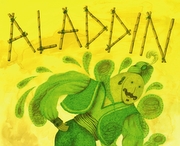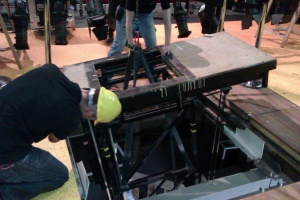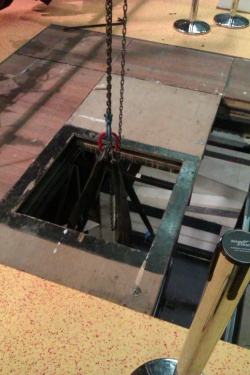Aladdin Panto 2011
| Aladdin Panto 2011 | ||||||||||||||||||
|---|---|---|---|---|---|---|---|---|---|---|---|---|---|---|---|---|---|---|

| ||||||||||||||||||
Aladdin
| ||||||||||||||||||
Cast
Abanazar - Chris Fulton (Max Greig)
Aladdin - Anthony Fagan
Dame - Mark Rowley
Emperor - Martin McBride
Empress - Natalie Songer
Genie - Brian(Christopher)Fisher
Narrator A - Ruby Richardson
Narrator B - Eve Ponsonby
Princess - Amiera Darwish
So Shy - Bobby Stewart
Wishee Washee - Ross Mann
Chorus - Sam Keefe, Cliodhna McCorley, Jimin Suh, Saria Steyl, Alasdair Hankinson, Molly Vevers, Lucy Hollis, Max Greig, Martin
Crew
Production Manager - Sandy McRobbie
Stage Manager - Sarah Wilson
Deputy Stage Manager - Hannah Nicol
Assistant Stage Managers - Amber McClelland,
Lighting Designer - Alexander Ridgers
Set Designer - Robin Peoples
Sound Designer - Jonathan Towers
Production Electrician - Fraser Walker
Deputy Production Electician - Melissa MacDonald
Technical Stage Manager - Fiona Nisbet
Deputy TSM - Rebecca Coull
Lighting Operator - Jade Beatson
Sound Operator - Jonathan Towers
LX Crew - Michael Parkin
Technical Crew - Neil Foulis, Graeme Brown, Kathryn Douglas, Ashley Kerray, Christopher McIntyre, Jane Paterson, Ben Terry, Natalie Wilson, Andrew McCabe
Set

The set for Aladdin consisted of large set pieces, a lot of flying pieces and cloths. The set was mainly flying pieces, with the peking palace scene required 8 bars for the one scene (not including the reveal gauze and black).
Click on the groundplan below twice to see a larger version.

Cloths

Cloths that were used for a number of scenes and scene changes were the US cyc, the starcloth used as a full black (and as a starcloth), and a full black for the demon cave.
The starcloth was mainly used for the flying carpet scene, so give it a romantic magical feeling. A slit needed put in the middle so that the flying carpet mechanism could operate through it.
Four other cloths were used as part of the cave scene; three cut border cloths and one that had a lamp shape cut out of it, for the actors to enter the cave.
The DS and MS cave cloths both had kabukis also attached to them, to transform the cave into a bollywood scene. An US hemp bar was also flown in to cover the US cave cloth.
Noodle Box


The noddle box was one of the more difficult pieces of set to move around. It was a truck shaped like a noodle box, with doors that opened and folded up on either side of the truck. A counter was inside the noodle box, which moved forward so that the actors could get behind it. It was the doors that made it difficult to move. A locating bolt was put on each door to help keep them closed, but because of the angle of them, it was a four person move to keep the doors closed.
The counter of the noodle box had a crew member underneath it to pass the actors props. As it was the chorus moving the noodle box on, and it was a fast move I wanted to make it as easy as possible, so having Jack inside was a great help. A cabin hook was put on to the inside of the truck, so once Jack was in it he could close the doors, and open once the truck was set.
Demon Cave

This was taken at the dress, so unfortunately the demon head wasn't working properly.
The demon cave was the second hardest piece of set to move around, as it would only fit in the scene dock with the wings open. This caused a lot of problems the first time we tried to move it offstage. The wings and head were made from a very strong foam as they needed to be lifted during the show, but will still very delicate.
During the show, the wings opened up, and then the head, with two glowing eyes (birdies), would lift up after. The wings were lifted with ropes that could cleat off on the back of the cave. One end was attached to a screweye in the middle of each wing, but due to the angle that the rope needed pulled, the crew members needed to practically be in the stage-wings, so cleating off wasn't possible during the show. The head was slightly more difficult and required to crew members. One to push the head slightly from the inside with a push stick, and another behind the cave with a rope to pull it upright.
Pyramid

The pyramid was the largest piece of set during the second act, taking up half of the scene dock. It had a solid wall with a door on one side, and the other three were gauze, with the US wall being in two pieces that could slide open. During the show, 3 crew members needed to push it, unseen, DS, and disappear down a trap behind it. Cast members and crew would then go up and down the trap on their cues, finally finishing with the baddie in the pyramid and having it spun by the cast to reveal him.
A picture of the Pyramid during the show
Technical Challenges
Genie Trap
The first thing that was done as part of the panto fit up was to lower the genie trap into place. The first that needed done was to find where the center point of the genie trap slider would be on stage, and make a bridal on the grid above this point. We made this using beam clamps and clutch chains. A shackle was then attached to the hook of the chain hoist and a rope dropped down to lift it up and attach to the point on the bridal.

Four slings were wrapped around the lid of the genie trap as this needed to be lifted on top of the genie trap mechanism and bolted on before it was lowered into the pit.

Once the lid was bolted on, ropes were attached to the genie trap to help guide it and the chain hoist (operated from the tallescope) was used to lift the genie trap off the ground slightly. On the first attempt at lowering it down, only one piece of staging was removed, which at the time seemed enough, but whilst lowering it we found that the trap had to be moved up and down stage to fit in; so the genie trap was lifted out again and another piece was taken out.

Just before getting it into its final position, packers needed placed between the beams in the stage and the trap to make it level with the stage. In the pit, a piece of 8by4 steel deck was placed underneath it with small screw jacks, to be able to change the height of the legs so the genie trap wasn't just floating in the pit.

Operating Genie Trap
Before operating the trap, unsure that the slider handle lock pin is in, the trap riser brake is on, the correct weight is added and the Perspex sheeting is in place. Have a spotter on the deck to ensure safety and the prop (length of box metal) on standby.
For Raising a Performer
- Once all of the above has been checked, allow performer on to the platform.
- Release locking pin from slider handle
- Once the green light has gone, turn the slider handle 3 ½ times, and release brake on the riser.
- Wait until the slider is fully open and pull down on the rope until the riser is level with the stage. Apply brake as soon as possible.
- Check locking pin is in the slider handle.
- Place prop between the floor and the top of the trap.
For Lowering a Performer
- Remove prop.
- Once all of the above has been checked, allow performer on to the platform.
- Wait until green light has gone (spotter and DSM are happy)
- Release locking pin on slider handle. Release brake on riser and pull rope up. Crew member on the entrance of the trap can assist by pulling the platform down, and then making sure performer stays on platform until brake is applied.
- Turn slider handle 3 ½ quickly with force until slider is in place.
- Check locking pin is in the slider handle.
Flying Carpet

The flying carpet mechanism was a collaboration between the production manager and the workshop tutors, who came up with something that had the 'magical' effect that the director was looking for. Due to the budget for the carpet being cut, the process went through quite a few different ideas, from turning it into a more of a joke (for example, having treads up to the carpet) to hiring machinery. In the end it was decided that a mechanism would be built from scratch and sold/rented out after the show.
The pictrue is of a basic model, that was made before the steel was bought, to make sure that the idea would work once built. It's basically a see-saw, but with the handle/cradle and the carpet on either end being seperate to the main arm. This means that both the carpet and the handle/cradle will be lifted/lowered, but remain flat and level at all times, to give the impression that the carpet is flying on its own.
To hide the mechanism the starcloth came in at the beginning of the scene, and the mechanism came on straight after, with the carpet being slid underneath the cloth. A slit was cut CS of the cloth so that the box steel attached to the carpet can move freely.

The carpet was operated with four crew members. Two were on the handle to make sure that if one had to let go for any reason there was always someone there; one made sure the performers were safely on/off the carpet and signaled to the fourth person, whos responsibility was to take out the safety pin which stopped the counter weight cradles from sinking.
Kabuki Drop
Kabuki Drops This page has a good diagram that helps my explanation make more sense. The main difference is that instead of a cloth falling to the ground, the cloths fall to cover something, but stay tied on to a counter weight bar.
The kabuki drop was used for the Bollywood scene, when the caves cloths needed to be hidden 'like magic' by colourful cloths. Two separate kabukis were used, both operated from the deck.
It was made from two lengths of 3x1 timber, each 6m, joined together. At regular intervals two screw eyes were put into the wood, one slightly higher than the other to help make sure that the pin didn't fall out. Attached to the timber along one edge was some white canvas with a 1m drop, which acted as a 'bag' for the colourful cloth.
A long length of sash was then tied to a straight stage pin through the loop at one end. That pin was then put in the first pair of screw eyes and more pins were added until the rope went all the way along the timber, and all the pins (and rope) went through the screw eyes.
The material was then tied onto the same bar as the timber was on and folded up inside the white canvas. Wherever the white canvas was against a pin, two holes were made next to each other. The pins were then all pulled out and from one end to the other each pin was put through the first screw eye in each pair, then through the holes in the white canvas, and then through the second pin.
Glitter Drop


The glitter drop that was used for Aladdin is a gradual one, spread over 1.5m. The glitter drop was made by using a piece of black cloth with slits, 3 small pulleys, 2 pieces of timber (the same width as the piece of cloth), enough black rope to go the SR end of the bar, reach the ground, and a separate piece to make a bridal. The size of the piece of black cloth should be as wide as you want to glitter drop to be. So if the width is 2m, the glitter will spread over 2m. The length of the cloth should be enough for the glitter to sit in and not fall, but we very close the the slits.
First, the black cloth had slits all along one have put into it, to make gaps for the glitter to fall out, and a piece of timber was stapled to each end to make it sturdy. I was lucky with the glitter drop that it was on the same bar as one of the kabukis, so I had 2 bars available to attach it onto. It is possible to do on one bar, but it would be messy, and the timber pieces would catch on each other a lot. The caught quite a lot even when we had two bars, so a small piece of scaff was attached to the top bar to move the pulley further out.
The timber on the slit side was then attached with cable ties onto the bottom bar and a pulley was attached to the center of the top bar. Orignally it was the other way round, but we soon realised that the slits would be on the lower side, and there was no way to keep the rope under tension when the bar was flown out. A bridal was then made for the other piece of timber, the long piece of rope attached and put through the pulley. Another pulley was attached to the end of the bar (with a scaff foot to stop it sliding off) to keep the rope in place.
At first this was operated from the fly floor, but it ended up being too temperamental and kept breaking, and the rope was left to hang, and operated from the ground like the kabukis.
Trap Door
About 5m US, a walk-down trap door was put in place to be used behind the pyramid. During the scene, various characters (and crew) use the trap to enter through the pyramid, and to exit through the pyramid and 'disappear'. The treads were originally made for Dracula, but can be used for any trap door position on the stage.




